The LG V20's claim to fame is that it was the first handset to ship with Android 7.0 Nougat out of the box, but it's really a lot more than that. For one thing, it contains such advanced features like a 3.5mm headphone jack and a non-exploding battery, so it already beats two of this year's second half flagships.
But all jokes aside, this device has really solid hardware, along with some great features. The second screen - which debuted in the V10 - can be very useful at times, and the camera is fantastic.
Specs
| CPU | Quad-core Snapdragon 820, dual 2.15GHz Kryo, dual 1.6GHz Kryo |
|---|---|
| GPU | Adreno 530 |
| Display | 5.7-inches, 1440p, 513ppi, IPS LCD |
| Body | 159.7 x 78.1 x 7.6mm, 174g |
| Camera | 16MP+8MP, Front 5MP |
| Video | 4K - 30fps, Front 1080p - 30fps |
| Aperture | f/1.8 + f/2.4, Front f/1.9 |
| Sensor size | 1/2.6" + 1/3.2" |
| Camera features | OIS, laser AF, PDAF, contrast AF dual camera, LED flash |
| Storage | 64GB, expandable to 2TB |
| RAM | 4GB |
| Battery | 3200mAh, removable |
| Audio | ESS Technologies ES9218 DAC, 32-bit 394kHz / DSD512 capable, 130dB SNR, 124dB DNR |
Design
I'm going to be completely honest here; I've never been a fan of LG's design. While the metal body of the V20 is sleek, it feels dull next to a Samsung Galaxy S7, iPhone 7 Plus, or HTC 10.
But while it's not winning any awards for most beautiful phone, it is practical. It's one of very few flagship phones on the market where you can still remove the battery, as it has a button on the lower-right side of the device to pop off the back cover. On a personal note, when I first saw the device, I was hoping that that was a camera button, as that's where one would typically be, and it would be great on such a camera-centric device.

On the upper-left side of the handset, you get your standard volume controls, which - first seen in the G5 - is a departure for LG. Previous models, such as the G4 and the V10, has the volume controls on the rear panel on the top and bottom of the power button, and in the V10's case, the fingerprint scanner.
The power button/fingerprint scanner, however, is in the same location, right below the cameras. On the bottom of the device, you'll find a USB Type-C port, as well as a 3.5mm headphone jack. Personally, I'm a fan of having both ports on the same side of the device, as it leaves the user able to more easily position the handset in a way that one of them isn't exposed to the elements.
Speaking of not exposing the device to the elements, the V20 passed the MIL-STD-810G Transit Drop Test. This means that the handset can be dropped repeatedly and still function, and LG says that it's "tough as nails".
Display
The LG V20 has a unique display. It has a 5.7-inch 1440p display, but above it is a 2.1-inch 160x1040 IPS LCD. To start with, the display is about as beautiful and vibrant as LCD panels get, the whites are white, and the colors are accurate. The blacks wouldn't fool me into thinking it's AMOLED, but it's a fine LCD, nonetheless.
Now, onto the second screen. Its main purpose is to show you the time, date, and notifications when the phone is asleep, as LG says that the average user wakes their phone 150 times a day, often just to check the time.
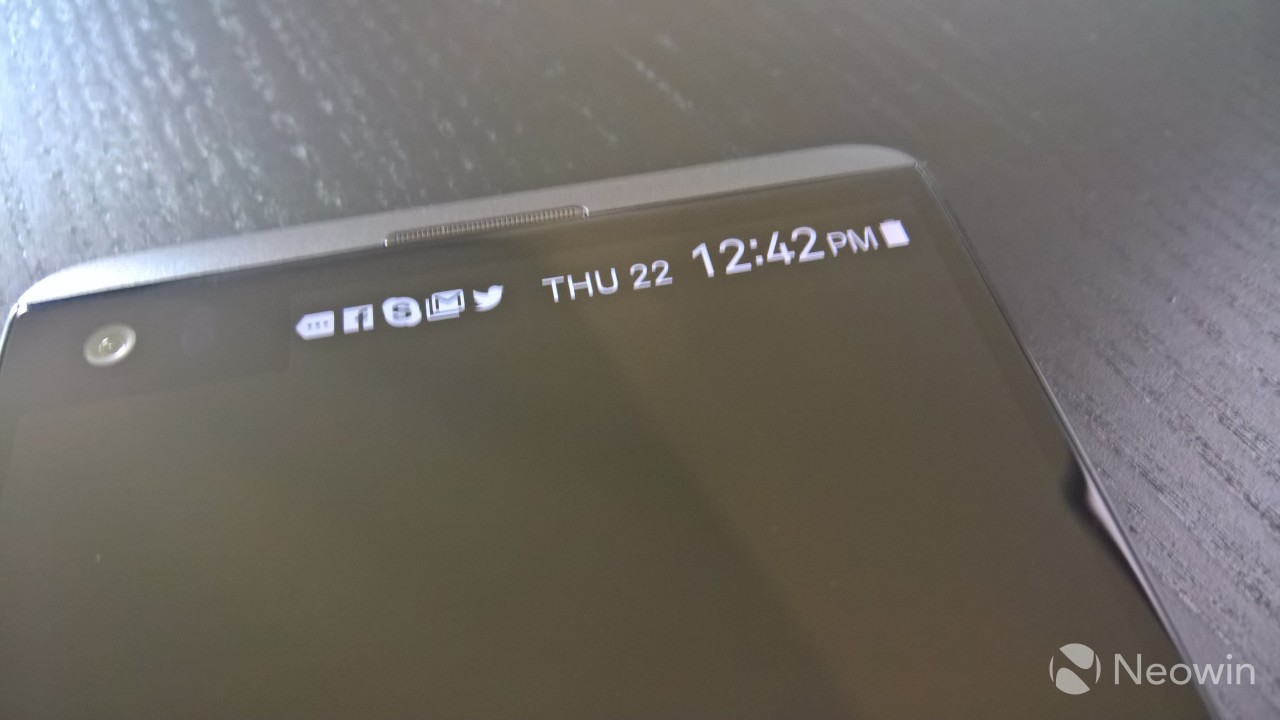
Other than the time/date/notification combo, you can swipe to the left to get to media controls or Quick Tools, which includes Sound profile, Wi-Fi, Flashlight, Bluetooth, and Capture+. The order of the Quick Tools can be changed, and you can add a Camera option, but that's about it.
Once the device is awake, you'll see a "signature". By default, this will be the user's name, but you can change the text and the font. Personally, I think that this is a complete waste of space. I'd much rather that space be used for app shortcuts or media controls.

But if you swipe left, you'll find those app shortcuts, which can be customized by long pressing the area, which will bring you to Settings. Quick Tools is also available when the handset is awake.
Those are all default settings. You can add other features to the second screen for when the device is awake, such as media controls, quick contacts, and upcoming plans. You can also kill that stupid signature.

When LG first introduced the second screen last year with the V10, many were quick to dismiss it a gimmick, as we reviewers tend to do with anything that's new (remember when 64-bit phones and fingerprint readers were gimmicks?). I've always thought that the second screen was an innovative solution to a real problem.
I find it super convenient to be able to get to media controls without bringing down the notification shade, or for notifications to appear on the second screen rather than taking up valuable screen real estate while I'm doing something.
It's certainly not perfect; for example, I'd prefer that the device use an AMOLED display, even if the main display was LCD and the second screen was AMOLED. LCD panels are entirely backlit, whereas an AMOLED only lights up the pixels that are being used. This is why you can see the backlight even when the phone is asleep (in the second screen area). You can set it to turn off at certain times, but I feel like it would just be better as an AMOLED.
Audio quality
OK, I'm no audiophile, so I'm certainly not the expert in this department. The LG V20 has a 32-bit Hi-Fi Quad DAC (digital to analog converter). The company says that it reduces ambient noise by up to 50%.
I can tell you that it sounds really good, and it should improve the quality of any pair of headphones. I've been using the pair of headphones that came bundled with the Amazon Fire Phone (yes, I know; I typically use headphones that came with phones because I have so many damn phones).

The feature needs to be turned on through Settings, so naturally, my super-scientific way of testing this was to listen to music while toggling it on and off. I was definitely able to tell the difference while testing it, and now I kind of want to listen to all of my music on the V20.
Naturally, the DAC only works with the 3.5mm headphone jack. It's a digital to analog converter, so it won't work with headphones that plug into the USB Type-C port or connect over Bluetooth. These would rely on the DAC in the devices themselves; for example, an analog signal can't pass over Bluetooth.
Rear camera
You might have noticed the dual-camera trend in smartphones lately, and the V20 is no exception to that. I'm going to compare it to the iPhone 7 Plus for a moment.
The iPhone 7 Plus has two 12-megapixel sensors, and the second one is used for a 2x lossless zoom. The V20 is the exact opposite, where the second sensor is meant to show you more, rather than less.
You might recall that the V10 also had a dual-camera setup, but in the front of the device, which served the exact same purpose for selfies. Obviously, LG has ditched the idea for the selfie camera and implemented it in the main camera.
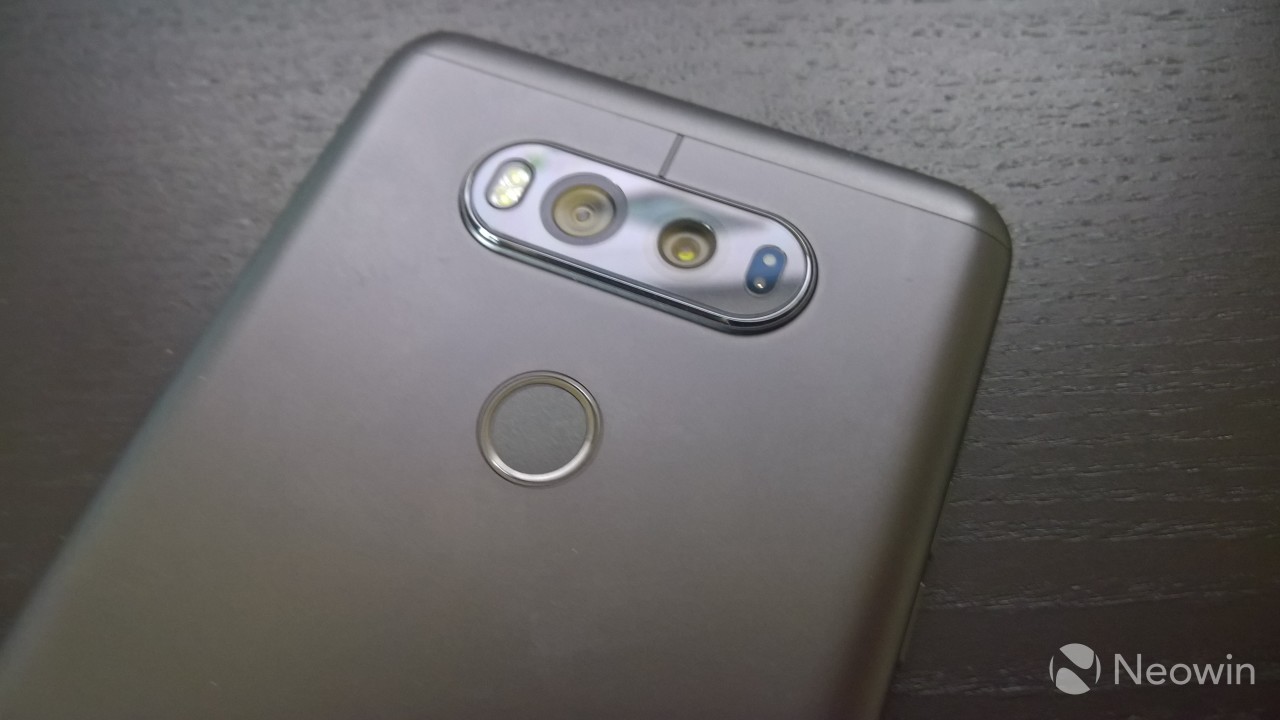
The thing that sort of bothers me is that the resolutions are different. The main 16-megapixel camera has a 75-degree lens, and the secondary 8-megapixel camera has a 135-degree lens, which LG says is wider than the human field of vision, which is around 120 degrees.
In short, you're getting a much wider field of view from a lower resolution camera, and since you're getting so much more in that shot, that's more likely to be the image that you want to crop, which would cause a significant loss in quality. A 720p display is only around 1MP, 1080p is about 2.1MP, and 4K is 8.3MP (these are all at 16:9), so anything smaller than that will be a noticeable difference.
And I have one more complaint that's equally tenuous. I complained about this when I reviewed the V10 as well (for the front camera though, of course), but it seems like the obvious feature to add here is the ability to use both lenses at once. For example, if I'm not sure if I want the main lens or the wide-angle lens, there should be an option to get both shots at once. Wouldn't that be the main benefit of two cameras, rather than having one wide-angle sensor and having the phone crop it?
Despite my admittedly tenuous complaints, I actually fell in love with the V20's rear camera. It uses a hybrid autofocus, which combines LG's traditional laser focus - which was implemented in the G3 - phase detection autofocus (PDAF), and contrast autofocus. The combination of these technologies makes it excel at focusing in low light, something that even the best smartphone cameras struggle with. Well, unless you do something stupid like try to tap-to-focus on the moon.
You can see that it takes excellent night-time shots, and it also does really well in tricky lighting situations, such as at a Microsoft event. But you also get a lot of control, as there are options for both manual photo and video modes.
Front camera
As I mentioned earlier, the V20 only has one front camera, unlike its predecessor. It's a 5MP sensor with an f/1.9 aperture and a 120-degree wide-angle lens.
It still offers the ability to switch between a more narrow selfie shot and a wider angle "wefie" shot, like the V10 did and the V20's rear camera does. You also get the opportunity to use the screen as a flash, something that LG was one of the first to offer.
While the low light performance of the front camera is pretty good, you can see that the flash can come in pretty handy.
But should you upgrade from the V10?
I normally don't include a section like this in a review, because it's usually pointless. Should you upgrade from an iPhone 6s Plus to an iPhone 7 Plus? Of course not; why would you break your two-year contract when you've already got a phone that you're probably satisfied with?
But I think that this is a different story. In this case, the V10 was a phone that I wasn't impressed with at all, and the V20 is a device that I fell in love with.

For one thing, I felt that the V10 underperformed. In fact, 2015 was a really rough year for Android phones in general. You had flagships that were powered by the Snapdragon 810, which overheated, and then companies like LG stuck with the Snapdragon 808, which wasn't very impressive. On top of that, everyone wanted a 1440p display, making the device very underpowered when attempting to do anything graphics-intensive, like mobile gaming.
The game that I've used for some time now to test this is Injustice: Gods Among Us. It's a big game that takes up a lot of space and uses a lot of GPU power, and many of 2015's Androids simply couldn't handle it. The V10 was one of those.
Fortunately, the Snapdragon 820 that's in the V20 - as well as most of this year's flagships - makes up for just about all of the shortcomings of its predecessors, and I've been very pleased with the performance of the handset.
The camera was another thing that I didn't care for on the V10 (by the way, most of what I'm saying in this section about the V10 also applies to the G4). LG really nailed it when the company introduced laser focus in the G3, but it just didn't feel as good the second time around. The device seemed to have trouble with autofocus.
Once again, that seems to be solved in the V20. As I mentioned above, the hybrid autofocus system works very well. I feel like the V20 is the V10 done right.
Benchmarks
As I mentioned in the last section, I've been very satisfied with the performance of the V20, as I have been with most flagship Androids that I've reviewed this year. The Snapdragon 820 is a solid chipset and the Adreno 530 GPU can handle 1440p far better than the Adreno 418 or 430 did.
But some of you won't be happy until you can see some benchmarks, which of course, we will provide. For the average user that's reading this to see if you should pick the V20 as your new phone, I'd skip this section, as benchmarks don't always reflect real-world usage.
I ran tests in both Geekbench 3 and 4. Geekbench 3 has been replaced, but its successor gives out different scores, so if you want to compare it with older devices that came out before Geekbench 4 was around, you might want to have access to both. Either way, it's just better to be thorough.
First up is Geekbench 3:

As you can see, Geekbench 3 puts it in the rankings next to older chips. Next up, Geekbench 4:

Naturally, the V20 scores similarly to other Snapdragon 820 devices, but you can see that it doesn't do quite as well as Samsung's Exynos 8890, which the company used in some international variants of the Galaxy S7, S7 edge, and Note7.
Next up is AnTuTu:

Again, the scores are similar to other Snapdragon 820 devices. This isn't at all surprising, as most Android phones that came out this year used the same chipset with the same resolution display; however, a handful of phones that came out in the second half used the Snapdragon 821, which has a slightly more powerful CPU.
Finally, GFXBench, which is for testing the GPU:

If you're not familiar with how this works, the regular tests show the results on the device's configuration, and the offscreen tests simulate a 1080p environment. So why would we want or need this?
A 1080p display is 2.1-megapixels, and 1440p is 3.7-megapixels, so with an additional 1.6 million pixels, that QHD display taxes the GPU quite a bit more. In other words, if Device A's GPU is slightly more powerful than Device B's, but Device A has a QHD display while B's display is FHD, B would probably still get the better result. The offscreen tests put the two devices on an equal playing field.
Conclusion
As you've probably realized by now, I've been super happy with the V20. In fact, it's hard to find anything meaningfully wrong with it. If I had to criticize something, it would be the boring design - in comparison with some of the more exciting-looking handsets out there - and the display, which is good, but not great. Recently, I actually booted up my HTC 10 and was reminded of just how beautiful an LCD can look.

But with those minor criticisms aside, I absolutely love the second screen, the device is powerful, it gets all-day battery life, and the audio sounds great. The camera is fantastic (and I'm a bit of a smartphone camera nerd), with a wonderful hybrid autofocus system that takes the best elements of PDAF, laser focus, and contrast focus.
We're closing in on the end of 2016, which means that if I'm going to say that one phone was the best of the year, I'll say this: the LG V20 is on the short list. If you're considering buying an Android phone, I don't think you can go wrong with this one.




















































































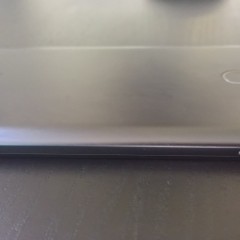

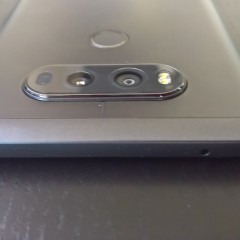
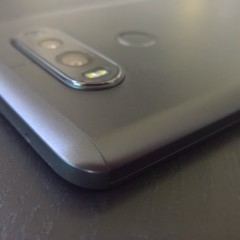
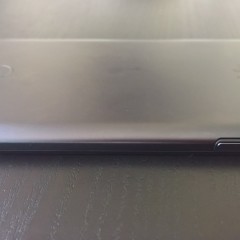
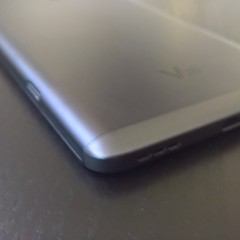
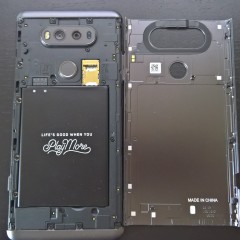

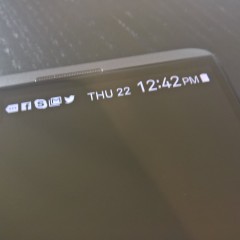

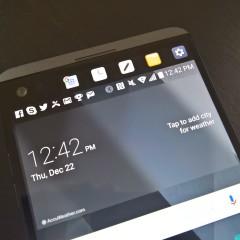
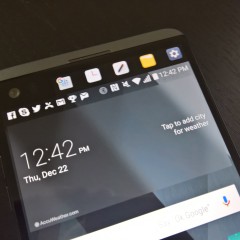
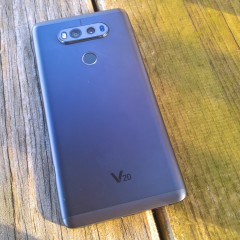
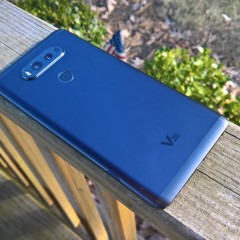
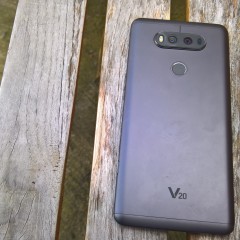









22 Comments - Add comment